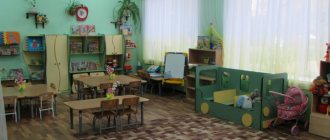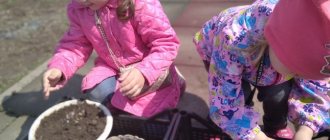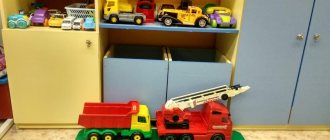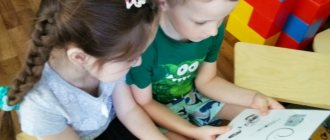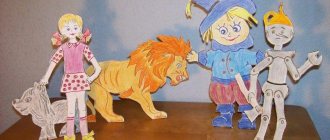TASKS OF LABOR EDUCATION OF PRESCHOOL CHILDREN BY GROUPS
1st junior group
1. Foster respect for people of any profession.
2. Emphasize the significance of the results of their work.
3. Support children's desire to help adults.
4. Introduce children to self-care
2nd junior group
Cultivate a desire to take part in work activities as much as possible.
Middle group
1. Foster a positive attitude towards work and a desire to work.
2. Learn to carry out individual and collective assignments, develop the ability to negotiate with the help of a teacher about the distribution of work, and take care of the timely completion of a joint task.
3. Form the beginnings of a responsible attitude towards the assigned task (the ability and desire to complete the work started, the desire to do it well).
4. Explain to children the importance of their work.
5. Encourage initiative in helping comrades and adults.
Senior group
1. Continue to expand children’s understanding of adult work. Show the results of labor and its social significance. Systematize knowledge about people’s work at different times of the year.
2. Talk about the professions of teacher, doctor, builder, workers in agriculture, transport, clothing industry, trade, etc.
3. Explain that a variety of equipment is used to make work easier (computer, cash register, electric sewing machine, etc.).
4. Introduce children to the work of people in creative professions: artists, writers, composers, masters of folk arts and crafts. Show the results of their work: paintings, books, sheet music, objects of decorative art.
5. Explain to children that the work of adults is paid, and people spend the money they earn on food, clothing, furniture, and on vacation.
6. Develop a desire together with adults and with their help to carry out feasible work assignments.
7. Learn to finish what you start.
8. Develop creativity and initiative when performing various types of work. Create responsibility for carrying out work assignments.
9. Teach the most economical working methods. Foster a work culture and respect for materials and tools.
10. Learn to evaluate the results of your work with the help of an adult.
11. Stimulate the desire to take part in work activities.
Preparatory group
1. Continue to cultivate interest in various professions and parents’ place of work.
2. Continue to introduce children to professions related to the specific local conditions.
3. Expand ideas about the work of adults. Foster respect for working people.
4. Create the need to work.
5. Foster a love of work.
6. Teach them to diligently and carefully carry out instructions, take care of materials and objects, and put them back in their place after work.
7. Cultivate a desire to participate in joint work activities on an equal basis with everyone else, the desire to be useful to others, to achieve results.
Methodical comment
The introduction of children to work begins with the 1st junior group. The main type of work at this age is self-care.
In the 2nd junior group, children continue to develop a desire for feasible work.
The volume of tasks for labor education increases from the middle group, reaching a maximum in the senior group. It is in the middle group that children actively master various work skills and techniques for working in nature, household and self-service work.
In the older group, manual labor is added. In the older group, greater emphasis is placed on developing all the skills and abilities available to children in various types of work. A conscious attitude and interest in work activities and the ability to achieve results are formed.
In the preparatory group, the developed skills and abilities are improved. But the basic foundation of children’s labor skills is laid in the older group
ON A NOTE. Pretend toys for kindergarten at low prices from the specialized store for teachers “Kindergarten” - detsad-shop.ru
SELF-CARE: Tasks and content of work in groups
1st junior group
1. To develop in children the ability to take care of themselves independently (while undressing, dressing, washing, eating).
2. Continue to teach children under the supervision of an adult, and then wash your hands yourself when they become dirty and before eating, wipe your face and hands dry with a personal towel.
3. Learn to put yourself in order with the help of an adult.
4. To develop the skill of using individual objects (handkerchief, napkin, towel, comb, pot).
5. Encourage children to be independent when eating, teach them to hold a spoon in their right hand.
6. Teach children how to dress and undress.
7. Learn to take off clothes and shoes (unfasten front buttons, Velcro fasteners) with a little help from an adult.
8. Learn to carefully fold removed clothes in a certain order.
9. Learn to put on clothes and shoes correctly.
2nd junior group
1. Continue teaching children to dress and undress independently in a certain sequence (putting on and taking off clothes, unbuttoning and fastening buttons, folding, hanging clothes, etc.).
2. Develop neatness, the ability to notice disorder in clothing and eliminate it with a little help from adults.
3. Continue to teach how to use soap correctly, carefully wash your hands, face, ears; Wipe yourself dry after washing, hang the towel back, use a comb and a handkerchief.
4. Learn to use tablespoons, teaspoons, forks, and napkins correctly.
Middle group
1. Improve the ability to dress and undress independently; teach to neatly fold and hang clothes with the help of an adult, put them in order - clean, dry
2. Cultivate the desire to always be neat and tidy.
3. Cultivate the habit of washing yourself, washing your hands before eating, when dirty, and after using the toilet.
4. Strengthen the ability to use a comb and handkerchief.
5. When coughing and sneezing, teach people to turn away and cover their nose and mouth with a tissue.
6. Continue to teach how to use cutlery correctly - spoon, fork, knife).
7. Learn to rinse your mouth after eating
Senior group
1. Form the habit of brushing your teeth and washing your face every day, and washing your hands as necessary.
2. Strengthen the ability to dress and undress independently, carefully put clothes in a closet, dry wet things in a timely manner, care for shoes (wash, wipe, clean, put away).
3. Learn to notice and independently eliminate disorder in your appearance.
4. Form the habit of taking care of personal belongings.
5. Develop a desire to help each other
6. Train yourself to brush your teeth and keep your nails clean.
7. Maintain order in your closet, put clothes in certain places
8. Learn to make your bed neatly
Preparatory group
1. Strengthen the ability to dress and undress independently in a certain sequence, correctly and neatly put clothes in the closet, put shoes in place, dry wet things in a timely manner, care for shoes (wash, wipe, clean).
2. Learn to notice and independently eliminate problems in your appearance, tactfully tell a friend about a problem in his suit or shoes, and help eliminate it. Develop qualities such as responsiveness and mutual assistance.
3. Learn to independently prepare materials and manuals for the lesson
4. Get into the habit of brushing your teeth, rinsing your mouth after eating, and washing your feet before going to bed.
By the end of the year, children can: dress and undress, keep their clothes in order, and, if necessary, put them in order.
ON A NOTE. Educational toys for kindergarten at low prices from a specialized store for teachers “Kindergarten” - detsad-shop.ru
ALGORITHMS OF SELF-CARE SKILLS BY GROUPS
Guidelines
The formation of self-service labor skills is closely interconnected with the formation of cultural and hygienic skills and affects their improvement. The algorithm will help the teacher in working on a long-term plan, in thinking through the sequence and choosing specific forms and methods of work for a more complete and timely formation of all self-service labor skills in children of each age group.
ON A NOTE. Didactic games for kindergarten at low prices from a specialized store for teachers “Kindergarten” - detsad-shop.ru
Duty corner in kindergarten: do-it-yourself design ideas
Marina Yakovleva 12/22/2017 5 14.2k
Preschoolers love to work and help their elders and friends. Their work is filled with rich content and plays a great educational role if organized using an aesthetically designed duty corner that takes into account the requirements of the program and the age characteristics of children. The teacher can make and equip the corner with everything necessary with his own hands, relying on the support of the students’ parents, as well as involving the children in this.
HOUSEHOLD WORK: Tasks and content of work in groups
1st junior group
1. Teach children to maintain order in the playroom and, at the end of the games, to place the play material in its place.
2. Involve children in performing simple labor activities. Together with an adult and under his supervision, place bread bins (without bread) and napkin holders on the table before eating.
2nd junior group
1. Encourage children to independently carry out basic tasks - prepare materials for classes (brushes, modeling boards, etc.); After playing, put away toys and building materials
2. Teach to maintain order and cleanliness in the premises and area of the kindergarten
3. Encourage to provide assistance to adults, to cultivate a caring attitude towards the results of their work.
4. In the second half of the year, begin to develop in children the skills necessary for serving in the dining room: helping to set the table for dinner (laying out spoons and forks, arranging bread bins, plates, cups, etc.).
Middle group
1. Teach children to maintain order in the group and in the kindergarten area: put away building materials, help the teacher, glue books and boxes.
2. Teach children to independently perform the duties of a canteen attendant: carefully arrange bread bins, lay out cutlery (spoons, forks, knives).
Senior group
1. Teach children to help adults maintain order in the group: wipe toys and teaching aids, wash toys and building materials, repair books and toys.
2. To develop the ability to clean up the kindergarten area: sweep and clear paths of debris, snow in winter, water sand in the sandbox
3. Teach children to independently and conscientiously perform the duties of the dining room attendants, to set the table, to clear away the dishes after meals.
4. Learn to independently lay out materials for classes prepared by the teacher, put them away, wash brushes, paint sockets, palettes, wipe tables
Preparatory group
1. Continue to teach children to constantly and promptly maintain order in the group and on the site: wipe toys and aids, wash toys, building materials, repair books and toys together with the teacher.
2. Continue to teach how to independently clean up the kindergarten area: sweep and clear paths of debris, snow in winter, water sand in the sandbox.
3. Learn to make your own bed after sleep
4. Accustom children to independently and conscientiously perform the duties of dining room attendants: setting the table in full, distributing second and third (berries, fruits) courses, clearing away dishes after meals, sweeping the floor
5. Learn to independently lay out materials for classes prepared by the teacher, put them away, wash brushes, paint sockets, and wipe tables.
By the end of the year, children can: organize their workspace and put it in order after classes are over.
Guidelines
The work of developing household skills in children is interconnected with the formation of the child’s general culture: setting the table correctly, cleaning the table, maintaining cleanliness and order in the room and area. Mastering labor and household operations makes a child independent and ready for adult life.
ON A NOTE. Role-playing costumes for kindergarten at low prices from the specialized store for teachers “Kindergarten” - detsad-shop.ru
Decoration of kindergarten. “Duty Corner” and “Mood Corner” with your own hands
Alena Polyakova
Kindergarten decoration. “Duty Corner” and “Mood Corner” with your own hands
I would like to introduce you to a small workshop for making the “ Duty Corner ”. For work we will need:
– 2 ceiling tiles
We cut out “pockets” from oilcloth - 6 small and 1 long, lay them out on the tile.
We staple the oilcloth pockets to the tiles
We bend the brackets from the bottom and glue 1 tile to another
Decorate pockets with ribbon
Here's what happened:
Now we add inscriptions and pictures
Well, we put the photos of the children in pockets. Finished corner :
I also made a mood corner , it hangs in the locker room.
Children independently, using cards, determine and show their mood .
And finally, children's tables are decorated with these autumn compositions on napkins. (I bought the pumpkins at a fixed price, the napkins were crocheted)
.
Do-it-yourself musical corner The musical development of a child comes down not only to classes with a teacher, but also to the opportunity to play independently and play music freely.
Master class “Duty Corner” with your own hands To decorate the group, we needed a duty corner. Of course, now you can buy different designs for corners, but I wanted to make it.
Master class “Do-It-Yourself Nature Corner” I would like to share with you my invention and bring to your attention the making of a nature corner. For production we will need.
Do-it-yourself parent's corner Good evening! I would like to present to your attention a do-it-yourself parent's corner. The parent corner is the face of the group. For a long time.
Do-It-Yourself Mummering Corner Children really like the Mummering Corner. I made a dressing corner in the shape of a matryoshka doll. We also sewed all the outfits ourselves. Here is the princess outfit.
Do-it-yourself fairy tale-noise maker “The Three Little Pigs” for a music corner A music corner competition was held in our kindergarten. Almost all the toys for the corner were made by hand. I want to suggest you do it.
Modern theater corner with your own hands To ensure an optimal balance of joint and independent theatrical activities of children in the group, a theater should be equipped.
Do-it-yourself nature corner I would like to share an idea for creating a natural corner with your own hands. To make a natural corner you needed: solid household waste.
Do-it-yourself “Mask-up” corner Good evening, dear colleagues! I would like to share my new idea - a do-it-yourself “Must-up” corner. The choice of the Matryoshka character was not accidental.
Do-it-yourself theatrical corner for the younger group. I invite you to see our new corner! Let me start with the fact that the work of a teacher is creative work. And creativity is a must.



